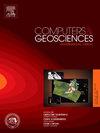一个Python脚本,用于平衡和不平衡系统的定量等层热气压测量
IF 4.4
2区 地球科学
Q1 COMPUTER SCIENCE, INTERDISCIPLINARY APPLICATIONS
引用次数: 0
摘要
等径面热压测量是将正演热力学模型生成的成分等径面与特定组合中测量的矿物成分进行比较,以检索平衡的压力和温度条件。在过去的二十年中,这项技术被广泛用于限制天然岩石样品的变质条件。然而,这种方法通常是定性地应用,依赖于几个选定相位的有限数量等线的相交。最近的作品引入了更多定量方法的软件解决方案;这些方法使用统计方法来推导最佳P-T条件,并对正演模拟结果提供更准确的解释。尽管取得了这些进步,但这些方法并不常用。IntersecT旨在使用Perple_X的WERAMI输出和应用多种方法(包括Bingo-Antidote中的质量因子概念)分发一个统计量化拟合质量的工具。该公式允许在等线热气压计中传播测量不确定度。此外,IntersecT应用简化的χ2统计来评估所考虑的阶段的权重,使由于模型不准确或不正确的假设(如不平衡特征)而导致的离群数据的权重降低。质量因素方法有助于可视化这些问题造成的差异。IntersecT提供了一个定量框架,以改进Perple_X等层热压测量结果的解释,允许考虑测量矿物成分中的不确定性。这种方法也可以帮助解释相平衡实验如何再现岩浆和变质系统中观察到的成分。本文章由计算机程序翻译,如有差异,请以英文原文为准。
IntersecT: a Python script for quantitative isopleth thermobarometry of equilibrium and disequilibrium systems
Isopleth thermobarometry involves comparing compositional isopleths generated from forward thermodynamic models with the measured mineral compositions in a specific assemblage to retrieve the pressure and temperature conditions of equilibration. This technique has been used extensively in the last two decades to constrain the conditions of metamorphism for natural rock samples. However, this method is often applied qualitatively, relying on the intersection of a limited number of isopleths for a few selected phases. Recent works have introduced software solutions with more quantitative approaches; these use statistical methods to derive optimal P–T conditions and provide a more accurate interpretation of forward modelling results. Despite these advances, these methods are not commonly used. IntersecT aims at distributing a tool for statistically quantifying the quality of fit using the WERAMI output of Perple_X and applying multiple approaches, including the quality factor concept from Bingo-Antidote. This formulation allows the propagation of measurement uncertainty in isopleth thermobarometry. In addition, IntersecT applies reduced χ2 statistics to assess the weight of the considered phases, enabling the down-weighting of outlier data due to model inaccuracies or incorrect assumptions, such as disequilibrium features. The quality factor approach helps to visualize discrepancies resulting from these issues. IntersecT provides a quantitative framework to improve the interpretation of Perple_X isopleth thermobarometry results, allowing compositional uncertainties in the measured mineral composition to be considered. This approach can also help interpret how phase equilibrium experiments reproduce the observed compositions for magmatic and metamorphic systems.
求助全文
通过发布文献求助,成功后即可免费获取论文全文。
去求助
来源期刊

Computers & Geosciences
地学-地球科学综合
CiteScore
9.30
自引率
6.80%
发文量
164
审稿时长
3.4 months
期刊介绍:
Computers & Geosciences publishes high impact, original research at the interface between Computer Sciences and Geosciences. Publications should apply modern computer science paradigms, whether computational or informatics-based, to address problems in the geosciences.
 求助内容:
求助内容: 应助结果提醒方式:
应助结果提醒方式:


